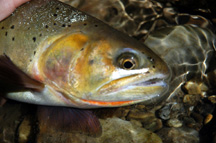ISU researchers document South Fork rainbow trout numbers
January 25, 2008
Idaho State University and Clemson University researchers say they were surprised to find that only 7 percent of trout sampled in Idaho’s South Fork of the Snake River drainage were introduced rainbow or rainbow-cutthroat hybrid trout that can threaten native cutthroat trout populations.  “We expected to find more rainbow trout and rainbow-cutthroat hybrids,” said Ernest Keeley, Ph.D., ISU biological sciences professor. “On the whole, the South Fork system in Idaho is in good shape as a Yellowstone cutthroat fishery.”
“We expected to find more rainbow trout and rainbow-cutthroat hybrids,” said Ernest Keeley, Ph.D., ISU biological sciences professor. “On the whole, the South Fork system in Idaho is in good shape as a Yellowstone cutthroat fishery.”
Some fisheries managers say they are concerned about the threat that introduced rainbow trout pose to the South Fork’s Yellowstone cutthroat population, one of 14 major cutthroat sub-species in the Western United States and Canada.
Where non-native rainbow have been intermixed with native cutthroat, the rainbow can interbreed with cutthroat and dominate the gene pool. This interbreeding has threatened and, in some cases, eliminated the cutthroat population in some waters – for instance the North Fork, also called the Henrys Fork, of the Snake River is primarily now a rainbow fishery. Besides the genetic dominance rainbows have, they are heartier fish that out compete cutthroat where they share the same waterway.
Keeley and a Clemson University, South Carolina, biological sciences professor Margaret Ptacek, Ph.D., (a former ISU faculty member), with assistance from several graduate students, completed a comprehensive study analyzing the genetic makeup of South Fork of the Snake River cutthroat trout.
The study was completed in 2005 and results were published in 2007. The researchers measured and took genetic samples from 1,200 trout (those fish were released live back into the water) in the South Fork and its tributaries in Idaho below and surrounding Palisades Reservoir, which straddles the Idaho-Wyoming border.
In the South Fork Snake River system around Palisades Reservoir – including major tributaries such as Pine, Rainy and Palisades creeks – less than 10 percent of fish sampled were rainbows or rainbow-cutthroat hybrids. However, there were “hot spots” of high populations of rainbows in the main stem of the South Fork: in some areas rainbows and hybrids made up as much as 30 percent of the fish population.
 Nearly 80 percent of the rainbows/hybrids sampled were either in the main river or on extreme lower ends of tributaries.
Nearly 80 percent of the rainbows/hybrids sampled were either in the main river or on extreme lower ends of tributaries.
Fisheries managers have already taken a number of steps to help stop the decline of the South Fork native cutthroat. Those steps include encouraging anglers to keep caught rainbows, while making it illegal to keep cutthroat; trying to mimic natural stream flows, including high spring flows, which benefit the cutthroat over the rainbow; and putting weirs on the lower ends of tributaries to prevent rainbows heading up them to spawn.
“Although introduced rainbows pose a threat, there is a strong chance for preserving the Yellowstone cutthroat in the South Fork because it still has its interconnected tributaries intact,” Keeley said.
The cutthroat can use the tributaries for spawning and for juvenile survival, and the fish can still return to the main river where they can grow to be large-bodied, healthy fish, he added.
The study mentioned is posted at www.isu.edu/~keelerne/Publications.html. Click the link with the description “Gunnell, K.,, Tada, M.K., Hawthorne, F.A., Keeley, E.R. and Ptacek, M.B. 2007. Geographic patterns of introgressive hybridization between native Yellowstone cutthroat trout (Oncorhynchus clarkii bouvieri) and introduced rainbow trout (O. mykiss) in the South Fork of the Snake River watershed, Idaho. Conservation Genetics, in press.
Photos provided by Dr. Ernest Keeley
Categories:
